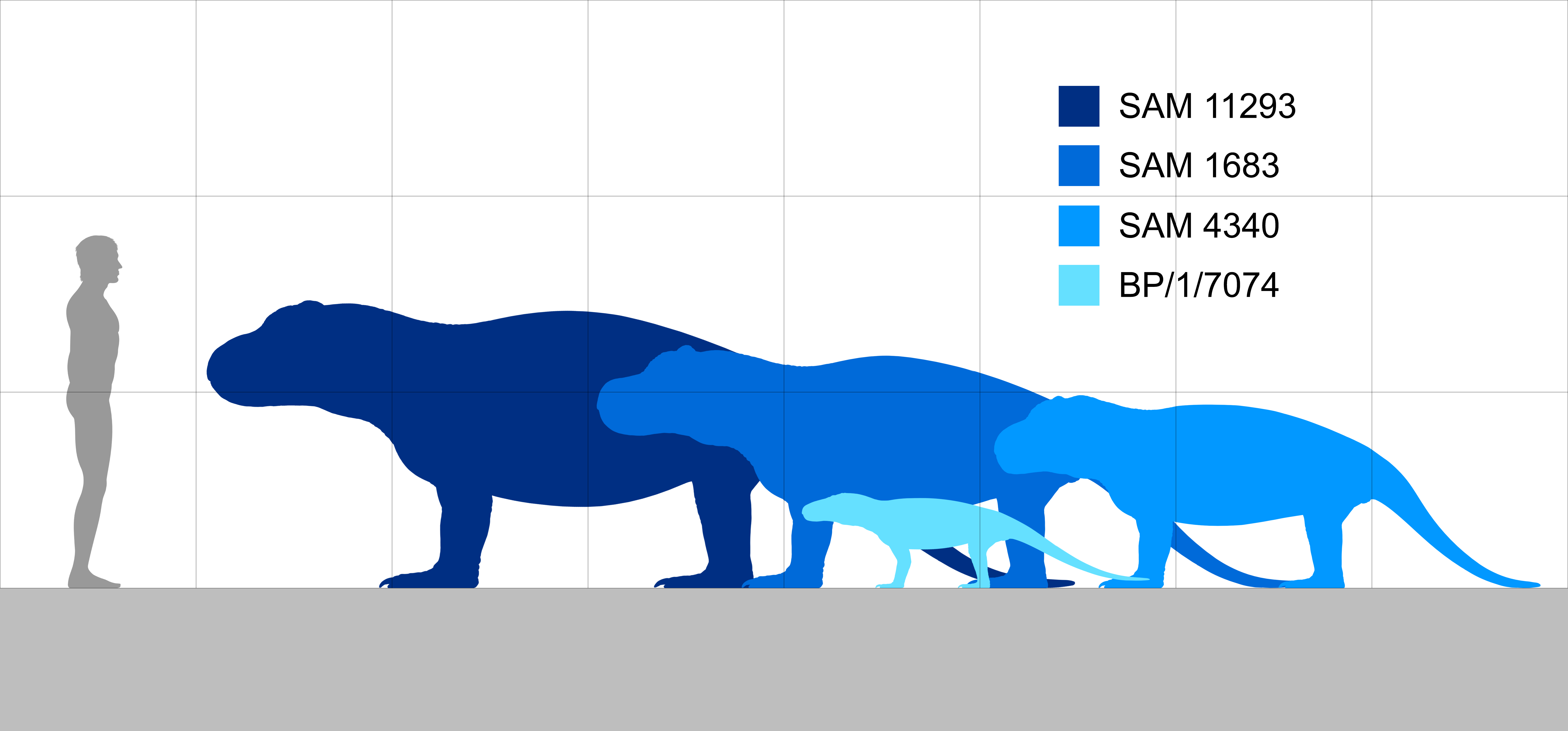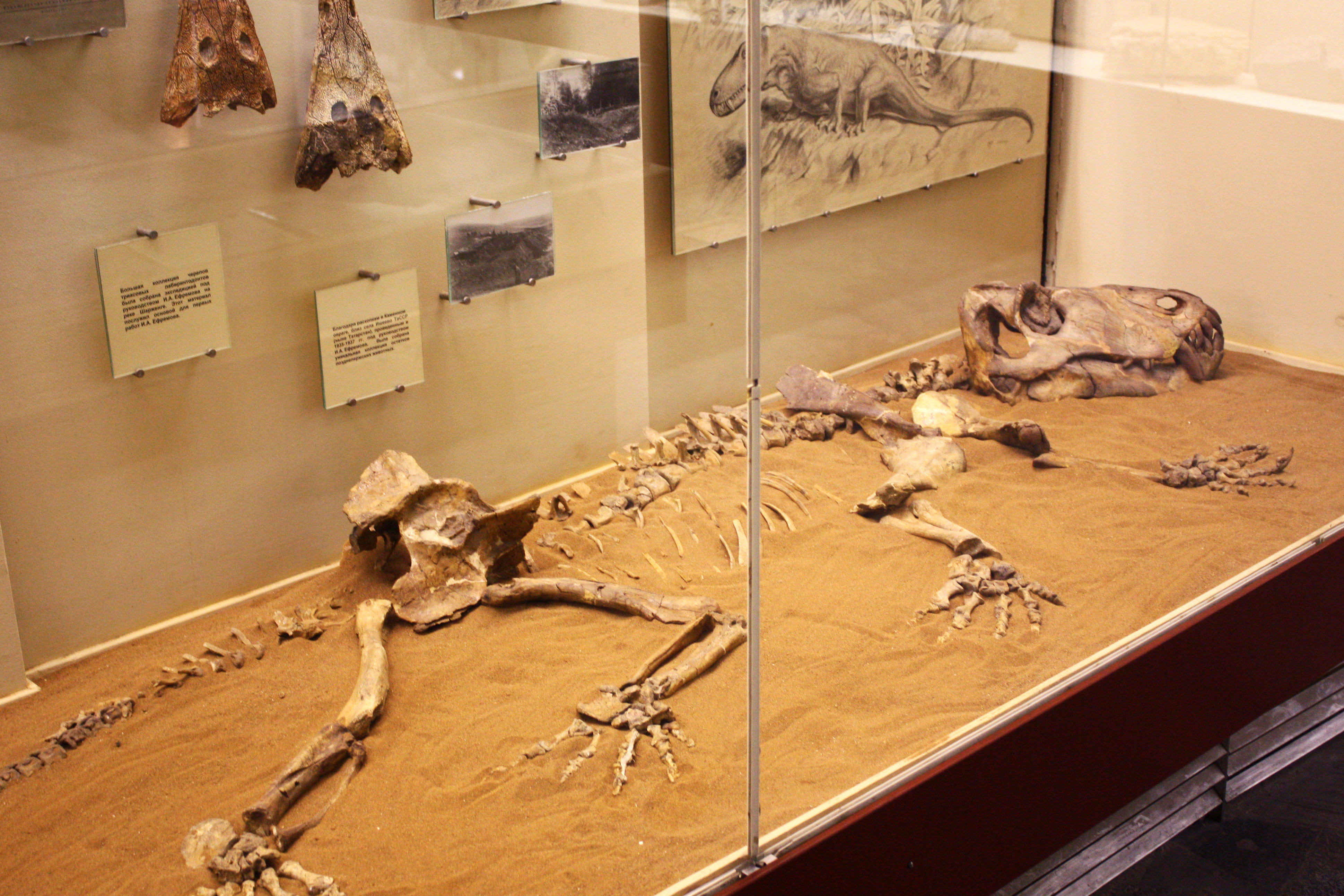|
Anteosauridae
Anteosauridae is an extinct family of large carnivorous dinocephalian therapsids that are known from the Middle Permian of Asia, Africa, and South America.These animals were by far the largest predators of the Permian period, with skulls reaching 80 cm in length in adult individuals, far larger than the biggest gorgonopsian. Description Anteosaurids are characterized by very large pointed incisors and canines, bulbous spatulate (spoon shaped) postcanines, a very strongly upturned margin of the premaxilla, so the front of mouth curves strongly upwards, and a long, very robust lower jaw (Boonstra 1963). Anteosaurids distinguished from '' Brithopus'' and other non-anteosaurid anteosaurians by the presence of a large thickened region or "boss" on the side of the angle of the lower jaw; this was probably used in intraspecific behaviour. In '' Doliosauriscus'' and '' Anteosaurus'', not only was this boss very prominent, but the bones were very thick and rugose. The same situa ... [...More Info...] [...Related Items...] OR: [Wikipedia] [Google] [Baidu] |
Paranteosaurus
''Anteosaurus'' (meaning "Antaeus lizard") is an extinct genus of large carnivorous dinocephalian synapsid. It lived at the end of the Guadalupian (= Middle Permian) during the Capitanian age, about 265 to 260 million years ago in what is now South Africa. It is mainly known by cranial remains and few postcranial bones. Measuring long and weighing about , ''Anteosaurus'' was the largest known carnivorous synapsid, non-mammalian synapsid and the largest terrestrial predator of the Permian period. Occupying the top of the food chain in the Middle Permian, its skull, jaws and teeth show adaptations to capture large prey like the giants Titanosuchidae, titanosuchids and Tapinocephalidae, tapinocephalids dinocephalians and large Pareiasauromorpha, pareiasaurs. As in many other dinocephalians the cranial bones of ''Anteosaurus'' are pachyostosis, pachyostosed, but to a lesser extent than in tapinocephalid dinocephalians. In ''Anteosaurus'', pachyostosis mainly occurs in the form of hor ... [...More Info...] [...Related Items...] OR: [Wikipedia] [Google] [Baidu] |
Anteosauria
Anteosaurs are a group of large, primitive carnivore, carnivorous dinocephalian therapsids with large canines and incisors and short limbs, that are known from the Middle Permian of South Africa, Russia, China, and Brazil. Some grew very large, with skulls long, and were the largest predators of their time. They died out at the end of the Middle Permian, possibly as a result of the extinction of the herbivorous Tapinocephalia on which they may have fed. Description The Anteosauria are distinguished from the Tapinocephalia by several features, such as very large canine (tooth), canines, cheek teeth with bulbous tooth crown, crowns, and an upturning of the premaxilla, so that the front of mouth curves strongly upwards. There is a tendency especially in more advanced forms such as ''Anteosaurus'' towards thickening of the bones of the top of the skull, indicating head-butting behavior. There is a large canal for the pineal organ (third eye); probably tied in with the animal's diurn ... [...More Info...] [...Related Items...] OR: [Wikipedia] [Google] [Baidu] |
Anteosaurinae
Anteosaurinae is an extinct subfamily of dinocephalian therapsids. It is one of two subfamilies in the family Anteosauridae, the other being Syodontinae. Description These are very specialized, very large anteosaurs. The postcanine teeth are further reduced. Deepening of the postorbital region of the skull (behind the eyes) produced a larger temporal opening, indicating more muscle mass. The boss on the angular (rear of the jaw) has become very prominent, again, another sign of powerful jaw muscles. These huge animals were formidable predators. In the Anteosaurinae, pachyostosis is taken to extremes. The dorsal (upper) surface of the nasal, frontal, and postfrontals (around and between/above the eyes) is thickened and rugose in the same manner as the tapinocephalids. Nevertheless, these animals are too specialized and too late to have been the ancestors of the herbivorous tapinocephalids, so these characteristics evolved independently. Boonstra notes that the hip joint and t ... [...More Info...] [...Related Items...] OR: [Wikipedia] [Google] [Baidu] |
Dinocephalia
Dinocephalians (terrible heads) are a clade of large-bodied early therapsids that flourished in the Early and Middle Permian between 279.5 and 260 million years ago (Ma), but became extinct during the Capitanian mass extinction event. Dinocephalians included herbivorous, carnivorous, and omnivorous forms. Many species had thickened skulls with many knobs and bony projections. Dinocephalians were the first non-mammalian therapsids to be scientifically described and their fossils are known from Russia, China, Brazil, South Africa, Zimbabwe, and Tanzania. Description Apart from the biarmosuchians, the dinocephalians are the least advanced therapsids, although still uniquely specialised in their own way. They retain a number of primitive characteristics (e.g. no secondary palate, small dentary) shared with their pelycosaur ancestors, although they are also more advanced in possessing therapsid adaptations like the expansion of the ilium and more erect limbs. They ... [...More Info...] [...Related Items...] OR: [Wikipedia] [Google] [Baidu] |
Syodontinae
Syodontinae is a group of dinocephalian therapsids. It is one of two subfamilies in the family Anteosauridae, the other being Anteosaurinae. They are known from the Middle Permian Period of what is now Russia and South Africa. One of the best known syodontines is '' Syodon'' from Russia. The South African form '' Australosyodon'', is one of the earliest known Gondwanan anteosaurs. Description Syodontines lack the boss on the lower jaw that characterises the related anteosaurines, and they have often been considered more primitive in this respect. Classification Below is a cladogram showing syodontine relationships from a 2012 phylogenetic In biology, phylogenetics () is the study of the evolutionary history of life using observable characteristics of organisms (or genes), which is known as phylogenetic inference. It infers the relationship among organisms based on empirical dat ... study of anteosaurians: References Anteosaurs Guadalupian first appearances Guad ... [...More Info...] [...Related Items...] OR: [Wikipedia] [Google] [Baidu] |
Doliosauriscus
''Titanophoneus'' ("titanic murderer") is an extinct genus of carnivorous dinocephalian therapsid from the Middle Permian. It is classified within the family Anteosauridae. The type species is ''Titanophoneus potens''. Remains of ''Titanophoneus'' have been found at Isheevo, Russia. Description An adult skull would have reached 80 cm with a heavy long snout. The long tail and short limbs show the species to be a primitive therapsid, unlike ''Inostrancevia,'' which was more advanced. The structure of the limbs and the density of the bone are designed for a sprawling stance. The temporal opening is more advanced than Estemmenosuchidae, but less advanced than ''Inostrancevia''. The teeth are large with 12 large palate incisors followed by 2 canines and various smaller back teeth. The lower palate is the same as the upper but without the canine teeth. The appearance of ''Titanophoneus'' is reminiscent to the sphenacodontid pelycosaurs, which included ''Dimetrodon''. Gallery F ... [...More Info...] [...Related Items...] OR: [Wikipedia] [Google] [Baidu] |
Titanophoneus
''Titanophoneus'' ("titanic murderer") is an extinct genus of carnivorous dinocephalian therapsid from the Middle Permian. It is classified within the family Anteosauridae. The type species is ''Titanophoneus potens''. Remains of ''Titanophoneus'' have been found at Isheevo, Russia. Description An adult skull would have reached 80 cm with a heavy long snout. The long tail and short limbs show the species to be a primitive therapsid, unlike '' Inostrancevia,'' which was more advanced. The structure of the limbs and the density of the bone are designed for a sprawling stance. The temporal opening is more advanced than Estemmenosuchidae, but less advanced than ''Inostrancevia''. The teeth are large with 12 large palate incisors followed by 2 canines and various smaller back teeth. The lower palate is the same as the upper but without the canine teeth. The appearance of ''Titanophoneus'' is reminiscent to the sphenacodontid pelycosaurs, which included '' Dimetrodon''. Ga ... [...More Info...] [...Related Items...] OR: [Wikipedia] [Google] [Baidu] |
Tapinocephalidae
Tapinocephalidae was an advanced family of tapinocephalians. It is defined as the clade containing ''Ulemosaurus'', ''Tapinocaninus'', and the Tapinocephalinae. They are known from both Russia and South Africa. In all probability, the Tapinocephalidae had a worldwide (Pangean) distribution. They flourished briefly during the Wordian and Capitanian ages, radiating into several lineages, existing simultaneously, and differing mainly in details of the skull and, to an even lesser degree, the skeleton. It is not clear how such similar animals could each find their own ecological niche, but such was obviously the case. There is a parallel here with the hadrosaur and ceratopsian dinosaurs of the Late Cretaceous. The cause of their abrupt extinction is not clear, since other smaller animals, and even the pareiasaurs, were not affected. Quite probably, like the extinction of the late Pleistocene megafauna, a number of factors were involved. Description The body is deep and capacious, all ... [...More Info...] [...Related Items...] OR: [Wikipedia] [Google] [Baidu] |
Ivan Yefremov
Ivan Antonovich (Antipovich) Yefremov, sometimes Efremov (; 23 April 1908 – 5 October 1972) was a Soviet paleontologist, science-fiction author and social thinker. He founded taphonomy, the study of fossilization patterns. Biography He was born in the village of Vyritsa in Saint Petersburg Governorate on 23 April 1908. His parents divorced during the Russian Revolution. His mother married a Red Army commander and left the children in Kherson to be cared for by an aunt who soon died of typhus. Yefremov survived on his own for some time, after which he joined a Red Army unit as a "son of the regiment" and went to Perekop with it. In 1921, he was discharged and went to Petrograd (now Saint Petersburg) to study. He completed his education there while combining his studies with a variety of odd jobs. He later commented that "the Revolution was also my own liberation from philistinism" (). Academic career In 1956, due to the influence of academician Petr Sushkin, he bec ... [...More Info...] [...Related Items...] OR: [Wikipedia] [Google] [Baidu] |
Middle Permian
The Guadalupian is the second and middle series/epoch of the Permian. The Guadalupian was preceded by the Cisuralian and followed by the Lopingian. It is named after the Guadalupe Mountains of New Mexico and Texas, and dates between 272.95 ± 0.5 – 259.1 ± 0.4 Mya. The series saw the rise of the therapsids, a minor extinction event called Olson's Extinction and a significant mass extinction called the end-Capitanian extinction event. The Guadalupian is also known as the Middle Permian. Name and background The Guadalupian is the second and middle series or epoch of the Permian. Previously called Middle Permian, the name of this epoch is part of a revision of Permian stratigraphy for standard global correlation. The name "Guadalupian" was first proposed in the early 1900s, and approved by the International Subcommission on Permian Stratigraphy in 1996. References to the Middle Permian still exist. The Guadalupian was preceded by the Cisuralian and followed by the Lopingian. ... [...More Info...] [...Related Items...] OR: [Wikipedia] [Google] [Baidu] |






